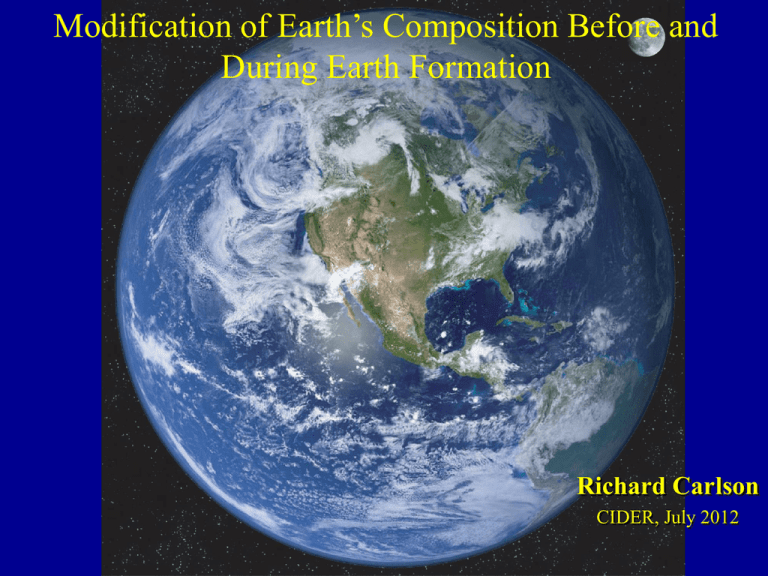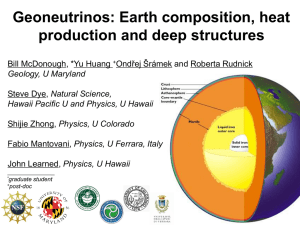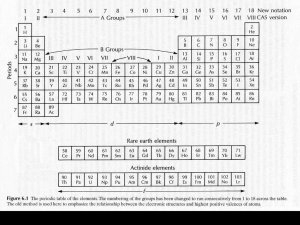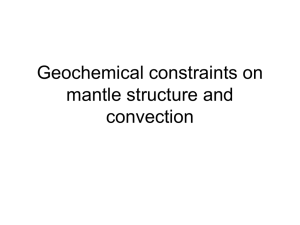Remnants of early Earth differentiation in today`s Earth
advertisement

Modification of Earth’s Composition Before and During Earth Formation Richard Carlson CIDER, July 2012 Molecular Cloud, M16 NASA/ESA When did planetary chemical differentiation begin? Before there were planets! Protoplanetary Disk, Hubble Telescope Not Everything was Volatilized! Small Grains from Other Stars Survived Photo of presolar SiC grain from Zinner, TOG 2003 Varying the whole rock presolar SiC abundance by less than a ppm would create the magnitude of anomalies seen in the whole rock C-chondrites Isotopic studies are revealing an ever increasing number of elements where Earth is isotopically distinct from most meteorites, particularly C-chondrites Figures from Warren (EPSL, 2011) Isotopically, Earth is Distinct from Most Meteorite Groups – Most Similar to E-Chondrites Only E and CI chondrites lie on the same oxygen mass fractionation line as does Earth (Figure from Clayton, TOG, 2004) Isotopically, Earth is not Solar! Heavy Water (+180, +180) Only E and CI chondrites lie on the same oxygen mass fractionation line as does Earth (Figure from Clayton, TOG, 2004, with the addition of Solar oxygen from McKeegan et al., Science 2011) Sun (-60, -60) Cooling of a Hot, Gaseous, Solar Nebula Can Cause Element Fractionation According to Condensation Temperature Condense Mineral Grains from a Cooling Disk of Gas Around the Proto-Sun Chondritic Meteorite as a Sample of Primitive Solar System Material CAI CAI = Calcium-Aluminumrich Inclusion. Composed of the minerals that would condense from a hot solar nebula at the highest temperature. Uranium-Lead Age of CAI’s from the Allende chondrite: 4.5686 ± 0.0002 billion years. (Bouvier et al., 2009) Some Meteorites have a Composition Similar to that of the Average Solar System, i.e. the Sun N C Li In? For most elements, CI chondrites provide a good approximation of solar composition CI-chondrites a good approximation for the building blocks of the terrestrial planets…at least to start with Solar and CI compositions from Palme and O’Neill, Treatise on Geochemistry, 2003 Dating the Processes that Modified Earth Composition Actively-used short-lived radioactive isotopes Parent Isotope Atom % Half-life (Myr) Daughter Isotope 26Al 0.005 0.73 26Mg 60Fe 3.7 x 10-7 1.5 60Ni 53Mn 0.00063 3.7 53Cr 107Pd 0.0015 6.5 107Ag 182Hf 0.0037 9 182W 129I 0.011 15.7 129Xe 244Pu 244Pu/238U 80 Fission Xe 103 142Nd = 0.0068 146Sm 0.026 Condensation – Volatile Loss: Al-Mg, Mn-Cr, Pd-Ag, Pb-Tl, I-Xe Metal – Silicate Separation: Fe-Ni, Pd-Ag, Hf-W, Pb-Tl Silicate Differentiation: Al-Mg, Fe-Ni, Mn-Cr, Hf-W, Sm-Nd Radioactive Decay: Pt = P0e-lt P = # of parent atoms l the decay constant (half-life = ln(2)/l) t = time Looking at it from ingrowth of the daughter isotope “D”: Dt = D0 + (P0-Pt) = D0 + Pt(P0/Pt-1) = D0 + Pt(elt-1) For the decay of 87Rb to 86Sr (50 Ga half-life) (87Sr/86Sr)t = (87Sr/86Sr)0 + (87Rb/86Sr)t(elt-1) For an extinct isotope the parent is gone! 26Al decays to 26Mg with a 730,000 yr half-life: (26Mg/24Mg)t = (26Mg/24Mg)0 +(26Al/24Mg)0 e-lt (26Mg/24Mg)t = (26Mg/24Mg)0 + (26Al/27Al)0(27Al/24Mg)te-lt A plot of measured 26Mg/24Mg vs. 27Al/24Mg yields a slope that corresponds to (26Al/27Al)0e-lt, but (26Al/27Al)t = (26Al/27Al)REF x e-l(tREF-t) To get an age from 26Al, you need to know its abundance (26Al/27Al)REF at some time, and you need to assume that its abundance was homogeneous across the Solar nebula at that time. Extinct nuclides thus give only relative ages – relative to a chronological reference point from an absolute age provided by a long-lived radiometric system High Chronological Resolution (Nyquist et al., 2009) Al-Mg systematics for calcium-aluminum-rich inclusions from various carbonaceous chondrites (Thrane et al., Astrophys. J., 2006) provide a potential age precision of ± 9000 years. Accuracy, however, is of the order 1 Ma due to remaining questions of extinct nuclide calibrations. Planetesimal Differentiation Started Within 2 to 6 Ma of Solar System Formation Markowski et al., 2007 Amelin, 2008 Glavin et al., 2004 Angrite D’Orbigny: U-Pb = 4564.3 ± 0.8 Ma Mn-Cr = 4562.9 ± 0.6 Ma Hf-W = 4562.4 ± 1.5 Ma Al-Mg = 4562.8 ± 0.5 Ma Iron Meteorite Tungsten Shows that Metal-Silicate Separation Happened Quickly, Even on Small Planetesimals DT (CAI) Ma 0 5 10 20 182 Hf decays to 182W with a half life of 9 Ma. W is soluble in iron metal, but Hf is not. When metalsilicate separation occurs, Hf and W are separated. In the metal, radiogenic ingrowth of 182W stops. Many iron meteorites have 182W /184W ratios similar to the Solar system initial value determined from CAIs. Others have higher 182W/184W consistent with ironmetal separation times of 20 Ma. The implication here is that Earth grew from already differentiated planetesimals, not primitive chondrites. (Kleine et al., EPSL, 2009) Extraction of Iron to the Core took with it all the Elements that are More Soluble in Iron than in Silicate (Siderophile Elements) Hf Cr Mn Volatility Trend Pd Figure from Palme and O’Neil, TOG, 2003 The Use of Hf-W, Mn-Cr and Pd-Ag to Constrain the Timing and Process of Earth Formation Hf-W sensitive only to core formation Pd-Ag sensitive to both core formation and volatile depletion Mn-Cr sensitive primarily to volatile depletion Core Formation Effect on Hf-W Earth Formed Volatile Depleted Chondrite Mn/Cr variation correlates with 53Cr/52Cr. Earth has a lower 53Cr/52Cr than almost all chondrites. Mn more volatile than Cr. Earth’s volatile depletion occurred while 53Mn was alive (t1/2 = 3.7 Myr) Earth From Qin et al., GCA 2010 Reconciling Mn-Cr, Pd-Ag, and Hf-W Constraints on the Timescale of Earth Volatile-Depletion and Core Formation 26 Myr accretion of volatile-poor material (86% of Earth mass) 4% CI added at 26 Myr Earth’s Mantle (Adds another 9% of Earth Mass) (Schonbachler et al., Science, 2010) The Evidence Against Chemical Exchange Between Core and Mantle AFTER the Completion of Core Formation Interaction of core with mantle will change the ratio of siderophile (Ni) to lithophile (Mg) elements. A variety of lithophile/siderophile element ratios show little or no change in the mantle over Earth history --> implies limited, if any, core-mantle exchange. After the arguments of McDonough and Sun, Chem. Geol., 1995 To this point we have formed an Earth that is depleted in volatile elements, probably because it formed from volatiledepleted planetesimals. We have seen that core formation occurred within the first 50-100 Ma of Earth history. What we haven’t talked about is whether these processes have had any effect on the main mass/volume of Earth – the mantle. Elements that are Neither Volatile, nor Siderophile, the Refractory Lithophile Elements, SHOULD be Present in the Silicate Earth in Chondritic Relative Abundances (but are not in most terrestrial rocks!) Element order reflects the degree of incompatibility during melting in the shallow mantle “Fertile” mantle xenoliths (from Palme and O’Neill, TOG, 2004, after Jagoutz et al., 1979) Systematics 146 1.14190 1.14180 Isua 0.004 1.14170 3.8 Ga 0.002 1.14160 0.000 1.14150 1200 0 200 400 600 800 Time after accretion (Myr) Coupled to the long-lived chronometer: 147Sm 143Nd (T 1/2 = 106 Ga) 147Sm abundance decreased by only 3% in 4.56 Ga 1000 Nd/144Nd Sm/144Sm Short-lived chronometer: 146Sm 142Nd (T = 68 Ma) 1/2 146Sm exists only in 0.008 Zircon the first ~500 Ma of 4.4 Ga 0.006 Solar system history 142 146,147Sm-142,143Nd Why Search for 142Nd Anomalies in Terrestrial Samples? • Because 142Nd anomalies have been measured in meteorites (eucrites, angrites), SNC meteorites (Mars) and lunar samples. Evidence for very early Sm/Nd fractionation Interpretation: Fractionation produced during the crystallization of a magma ocean Borg et al., 1999; Boyet and Carlson 2007; Foley et al., 2005; Harper et al., 1995; Nyquist et al., 1995; Brandon et al. 2009. MARS MOON • A magma ocean stage has wide support : e142Nd - Accretion model (large impacts in late stages) - Very short-lived extinct radioactivity (26Al, 60Fe) - Core formation liberates lots of gravitational potential energy 142Nd Variation in Earth Materials is Limited and Restricted Only to Rocks Older than 2.7 Ga 142Nd excesses measured in 3.8 Ga samples from SW Greenland and Anshan, China (up to 0.15e). 142Nd deficiencies in Nuvvuagittuq, Quebec, Canada • Evidence for early differentiation, but not seen in all old rocks • No heterogeneities in 142Nd/144Nd preserved after 2.7 Ga in Earth’s convecting mantle 142Nd Excess Implies a Higher than Chondritic 143Nd/144Nd for the “Primitive” Mantle if the Sm/Nd Ratio Responsible for the Excess 142Nd is Maintained Over Earth History Mid-ocean ridge basalts 5 Ma, 147Sm/144Nd=0.209 30 Ma, 147Sm/144Nd=0.212 60 Ma, 147Sm/144Nd=0.216 100 Ma, 147Sm/144Nd=0.222 chondritic evolution Archean samples “Chondritic” mantle is a very muted component in intraplate volcanism One explanation – regulate mass transfer rates between depleted upper mantle and primitive lower mantle to match erupted compositions, e.g. Kellogg et al., EPSL, 2002 “primordial” chondrite reservoir (Ra) Predicted Parental Mantle Reservoir from 142Nd Overlaps with high 3He/4He Reservoir Reservoir parental to terrestrial mantle • Though there are complexities (age corrections, crustal contamination), the Pb isotopic composition of many flood basalt parental magmas plot near circa 4.5 Ga geochrons. •All the colored symbols on this figure have e143Nd between +5.3 and +8 and were selected as those samples least affected by crustal contamination. Jackson & Carlson, Nature, 2011 Evidence of a “late”Global Terrestrial Differentiation Modern Terrestrial Mantle Chondritic Magma ocean crystallization = 120+28 -22 Ma Both the Moon and Earth show little lithophile evidence for 4.56 Ga differentiation. Instead, the 146Sm-142Nd data for lunar crustal rocks, mare basalts, and the Isua rocks with positive 142Nd anomalies suggest a global differentiation age in the circa 4.45 Ga range – similar to Pb ages for Earth. Is this the time of the giant impact and Moon formation? Superchondritic 143Nd/144Nd of Mantle Throughout Earth History Early differentiation coupled with a short period of mixing between enriched and depleted reservoirs can explain both 142Nd and 143Nd variation in mantle-derived rocks through time. Complementary enriched reservoir may no longer exist if BSE is non-chondritic. 142Nd/144Nd in Archean Mantle-Derived Rocks Initial e143Nd in Mantle-Derived Rocks Figure after Shirey et al., 2007 with data from numerous literature sources From Carlson & Boyet, Phil. Trans. 2008 The Post Magma Ocean Overturn, and a Period of Quiescence Magma ocean crystallization leaves a buoyantly unstable cumulate pile. Overturn leaves cold, dense, material at the base, and hot, buoyant, material near the surface. Large-scale mantle convection impeded until radioactive heating reestablishes a thermal gradient sufficient to overwhelm compositional density. Density Elkins-Tanton et al., EPSL, 2005 Two Ways to Create an EDR – EER Pair Magma Ocean Overturn Basal Magma Ocean (Labrosse et al., Nature 2007) Calculated Lithophile Trace Element Pattern for Early Depleted Reservoir Calculated from 142Nd/144Nd Mass Balance Modeling Jackson and Jellinek, in prep. How Did the Non-Chondritic Mantle Form? Melting is the easiest way to fractionate the lithophile elements, but what were the conditions of melting? N-MORB -MORB OIB Cont. Crust Gd Y Yb Dy Er Distribution Coefficient 100 Garnet Clinopyroxene 10 1 0.1 0.01 0.001 Rb Th Nb Ce Sr Hf Sm Gd Y Yb Ba U La Pb Nd Zr Eu Dy Er Conclusions 1) Earth inherited compositional variation present the nebula • Volatile depletion (present by 4564 Ma), high Fe content • Isotopic distinction, particularly from C-chondrites 2) Global differentiation of Earth and Moon occurred at ~4.45 Ga, not ~4.56 Ga • 120-150 Ma lunar crust and mare basalt isochrons consistent with 142Nd excess in Isua and Pb “Age of the Earth” 3) Accessible Earth slightly depleted in highly incompatible lithophile elements • Explains: • The most common Nd isotopic composition seen in OIB • The positive eNd seen even in the oldest mantle-derived rocks • Association of high 3He/4He mantle with positive eNd • The 40Ar “paradox” • U, Th, and K abundances in the non-chondritic BSE are 60% those generally assumed • Flood basalts preferentially sample the non-chondritic primitive mantle 142Nd Variations - Radiogenic or Nucleogenic Half-life > 109 yr Number of Protons 66 65 64 63 62 61 60 59 58 57 56 55 54 53 52 Dy Tb Gd Eu Sm Pm Nd Pr Ce La Ba Cs Xe I Te 125 73 Days to 108 yr Minutes to Days < Minutes 156 144 136 130 132 128 127 126 129 74 75 130 129 128 131 76 77 134 133 132 138 135 136 135 134 138 137 142 141 140 139 138 143 146 147 148 144 145 146 85 86 149 152 151 150 154 153 152 148 150 158 155 156 157 160 159 158 93 94 154 142 136 130 78 79 80 81 82 83 84 87 88 89 90 91 92 Number of Neutrons S-Process Slow Neutron Addition R-Process Fast Neutron Addition P-Process Proton-rich Nuclei 142Nd Variations - Radiogenic or Nucleogenic? Pre-Solar grains in meteorites preserve massive Nd isotope anomalies including huge enrichments in 142Nd Data from Richter et al., 1992 Nd is Nucleosynthetically Variable, but is that the Answer to the Chondrite – Earth 142Nd Difference? 92Mo anomalies may correlate with 142Nd anomalies (Burkhardt et al., 2011) Angrite NWA 4801 Nd displays small nucleosynthetic anomalies in C-chondrites at the whole rock scale. CM are s-process depleted, CI are sprocess enriched. Both have negative 142Nd anomalies compared to Earth. Angrites, with no measureable Mo isotope anomaly have m142Nd = +3 (NWA 4590), -7 (NWA 4801) and +3 (D’Orbigny) (Sanborn et al., LPSC 2010) relative to chondrites, in other words, 15 to 25 ppm lower than Earth. Few meteorites have both 142Nd/144Nd and 148Nd/144Nd that simultaneously overlap terrestrial values. E-chondrites come closest, but even they show a range of isotopic compositions (Qin et al., GCA 2011) Nd Suggests an Incompatible Element Depleted BSE. Why do Hadean and Eoarchean Zircons Show Negative eHf? (Bizzarro et al., G3 2012) Age (Ma) 53Mn Element Mn Cr Mn/Cr Condensation T [CI Chondrite] 1158 oK 1920 ppm 1296 2650 0.72 107Pd Element Pd Ag Pd/Ag [Mantle] 1045 ppm 2625 0.40 [Core] 300 ppm 9000 0.033 107Ag (6.5 million years) Condensation T 1324 oK 996 182Hf Element Hf W Hf/W 53Cr (3.7 million years) [CI Chondrite] 550 ppb 200 2.8 [Mantle] 3.9 ppb 8.0 0.5 [Core] 3100 ppb 150 21 182W (9 million years) Condensation T 1684 oK 1789 [CI Chondrite] 103 ppb 93 1.1 [Mantle] 283ppb 29 10 [Core] 0 ppb 470 0 Oxygen: A Clear Indication that the Solar Nebula was not Compositionally Homogeneous Nucleosynthetic Or Chemical? Nucleosynthetic Variations (Figure courtesy of Larry Nittler) U-Pb ages provide a suitable absolute reference age for rocks that can be dated by UPb. One can also compare one extinct system against another. Nyquist et al., 2009 Pd-Ag Core Formation Timescale Too Fast for Hf-W! Accrete volatile-rich material – volatiles lost in later event Dashed curves are for accumulation of material as volatile-depleted as Earth today (Pd/Ag = 13). Solid curves are for accumulation of CV3 chondrites (Pd/Ag = 8.5). Numbers along the curves in A give the mantle Pd/Ag ratio after core formation. If Earth accumulated from volatile-rich material, then Pd-Ag offers no constraints on the timing of core formation. (From Schonbachler et al., Science 2010) Isotopic Compositions Influenced by Presolar Grains (Qin et al., GCA 2011) Grains with anomalies of this magnitude may influence isotopic composition, but do they influence elemental composition? Ice-Rock Separation: Volatile depletion (never enrichment) is a characteristic of many Solar system objects, including Earth From McDonough TOG, 2003 CI-normalized terrestrial volatile element abundances decrease with decreasing condensation temperature. Same pattern, though less extreme, is seen in “primitive” meteorites. Volatile depletion of Earth is a “pre-accretion” phenomena Timing of Planetary Volatile Depletion via Rb-Sr The Importance of that Last 1% of Accretion Earth = 6 x 1024 Kg Ocean = 1.4 x 1021 Kg CI Chondrite = 18 wt% H2O 1% Earth Mass of CI Chondrite contains 1021 Kg water 142Nd • Difference Between Earth and Chondrites 142Nd/144Nd ratios measured in carbonaceous and ordinary chondrites and basaltic eucrites are lower than all modern terrestrial rocks. Enstatite chondrites (Gannoun et al., PNAS, 2011) overlap both O-chondrite and terrestrial mantle values. Explanation : • BSE has a Sm/Nd ratio ~6% higher than O-chondrites. High Sm/Nd ratio results in excess 142Nd from the decay of 146Sm. Data from Nyquist et al., 1995; Boyet and Carlson, 2005; Andreasen and Sharma, 2006; Rankenburg et al., 2006. Carlson et al., 2007; Gannoun et al., 2011.










